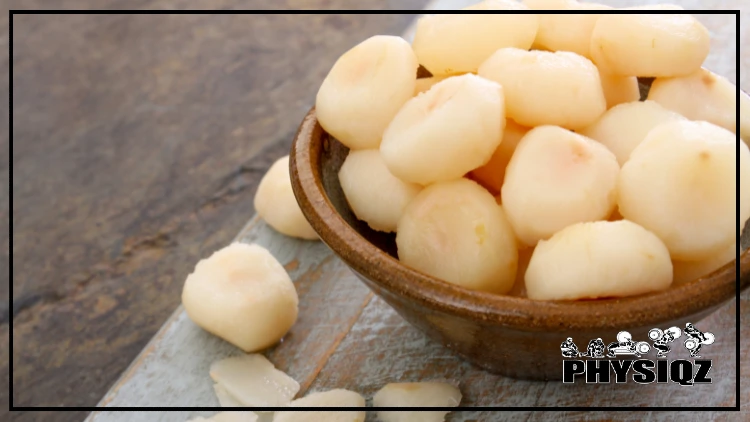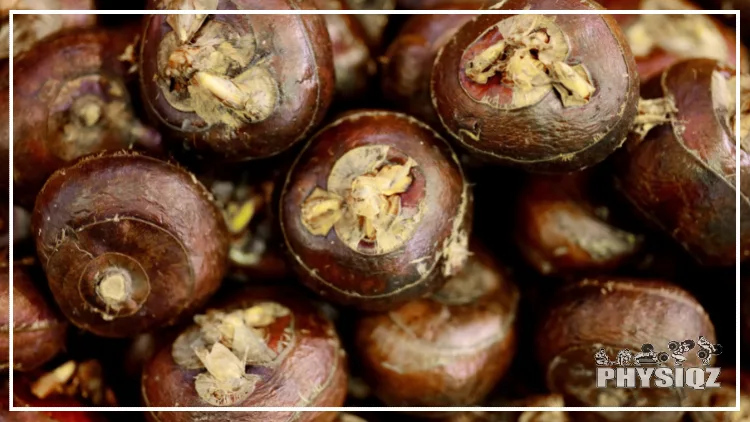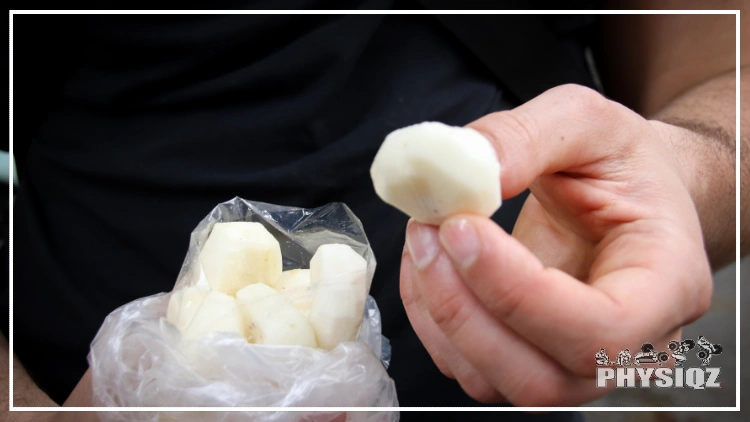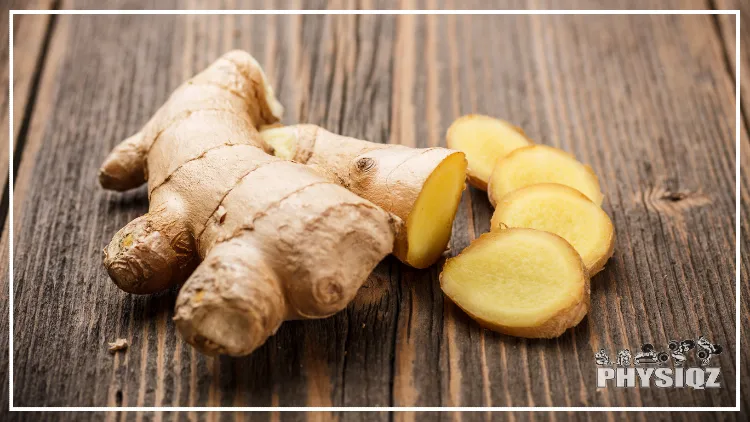
Whether or not water chestnuts are keto-friendly is a question often asked by low-carb dieters who want to keep the tasty and nutritious vegetable on the menu since it’s loaded with health benefits.1
However, using these keto alternatives below that are not bamboo shoots may prove to be lower in carbs then both water chestnuts and bamboo shoots. So don’t go with any ole alternative, go with the best low carb alternatives instead.
Is Water Chestnut Keto-Friendly?
Water chestnuts are typically not considered keto friendly. A ketogenic diet (keto) is a diet that limits the amount of carbohydrate intake to between 20 and 50 grams based on a 2000 kcal diet.2 This awesome vegetable, therefore, unfortunately, provides almost half the daily allocation of a keto diet.
While they have a high amount of carbs, they conversely have a low amount of calories and their ability to be combined with several meals such as stir-fries, salads, or even dumplings makes them an attractive option, but this does still not make them keto for those wondering if water chestnut is keto friendly.
What Makes Water Chestnuts Non-Keto?
Water chestnuts are not nuts but are a vegetable and a type of aquatic tuber laden with starch, making them very rich in carbohydrates and non-keto. Tubers are essentially storage structures for plants to store nutrients during lean times and as a way of asexual reproduction.3

Source: luxiangjian4711 via Canva.com4
They have a high glycemic index due to their high starch content—this measures blood sugar or glucose levels after consuming food high in carbs. When this index is high, there is a greater spike in blood sugar after eating high-carb food. Maintaining low blood sugar is key to a keto diet, making them less than ideal as a low-carb option.
In addition, water chestnuts have a very low-fat content which is essential to a keto diet. The keto diet, characterized by its emphasis on net carbs, high fat, and moderate protein intake, prioritizes fat as the main energy source. This lower carb consumption encourages the body to burn fat, positioning it as one of the effective weight loss solutions.5
They are heavily loaded with carbohydrates, as a serving of 100 grams contains 20 grams of net carbohydrates. Carbohydrates consist of starch, fiber, and sugars—the net carbs are the actual carbs that are consumed by the body computed by the difference between the total carbs and fiber.6 Typically, fiber is not ingested or absorbed by the human body and is passed out as waste.
Water Chestnut Carbs, Keto Net Carbs, & Nutritional Information
Water chestnuts, as stated before, are quite high in carbs, more so even than other tubers, let alone vegetables. They are low in fat, rendering them less than ideal for keto—here is a breakdown of the nutritional information for a serving of 36 grams (4 pieces) and 100 grams water chestnuts.7
Four Water Chestnuts (36 grams)
- Total Carbs (grams): 8.6
- Fiber (grams): 1.08
- Net Carbs (grams): 7.52
Four Water Chestnuts (100 grams)
- Total Carbs (grams): 23.9
- Fiber (grams): 3
- Net Carbs (grams): 20.9
Water chestnut serving of 36 grams (4 water chestnuts) of other macronutrients:
Protein: 0.5 grams
Fat: 0.03 grams
Calories: 34.9 kcal
Water chestnut serving of 100 grams of other macronutrients:
Protein: 1.4 grams
Fat: 0.1 grams
Calories: 97 kcal
Water chestnuts are not ideal to in while on keto, as demonstrated by the figures above. Eating water chestnuts has a risk of throwing someone off of a keto diet.
Water Chestnuts Health Benefits
Harvested when the bulb turns brown, water chestnuts are crisp and can be consumed both raw and cooked and have numerous health benefits. They are very versatile vegetables that are sweet and confer gains such as having a high amount of antioxidants, are very low in calories, can lower blood pressure, and can reduce incidences of heart disease and cancer.
Good for digestion—these vegetables have a high amount of fiber which is beneficial to the digestive system by enlarging both size and weight of the stool, which is easier to pass, thus preventing constipation thus supporting healthy bowels.
Low in calories—water chestnuts are low in calories making them ideal for weight loss by reducing the number of calories consumed, enabling a calorie deficit.
Blood pressure control—water chestnuts contain a high amount of potassium. Potassium can lower blood pressure in people who have problems with hypertension (high blood pressure) while lowering the risk of strokes.8
High amount of antioxidants—antioxidants help guard the body against radicals; radicals are produced when the body breaks down food and builds in the body, causing oxidative stress. Water chestnuts have many antioxidants, such as catechin gallate, gallocatechin gallate, and ferulic acid, which counter free radicals, thus preventing and slowing chronic diseases.9
Lower risk of heart disease—the high amount of potassium in these vegetables is also linked to lower incidences of heart disease as potassium aids the heart to beat correctly by helping maintain the electrical signals.10
Can prevent cancer—one of the oxidants contained in water chestnuts known as ferulic acid can suppress the growth of breast cancer and skin, lung, bone, and thyroid cancer cells.11,12 Cancer thrives on free radicals to spread and grow in size; as a result, eating this vegetable can provide a key cancer-fighting tool in a diet. Studies are still ongoing, but the data is promising.
They help control diabetes— due to the high amounts of healthy fiber, antioxidants, and vitamins, water chestnuts may be a key factor in helping a diabetic manage sugar levels.
Antibacterial properties—red and green water chestnuts have extracts that can kill bacteria and the infections they cause; adding them to a diet is beneficial.13
Low in fat—their low-fat content, though not ideal for a keto diet, is beneficial for those not wanting to consume too much of it. They are a great source of nutrients without the baggage of too much fat.
Manganese and copper— these metals are important components of the human diet to help maintain normal body functions. Manganese helps maintain strong, healthy bones. Copper is good for the heart, maintaining energy levels, and is a key factor in the production of collagen, which is good for the joints.
Contains vitamins such as B6 and B2—vitamin B6 is critical to liver functioning and skin and eye health. Riboflavin, also known as vitamin B2, is key to helping the body break down carbohydrates and is essential to energy production. Water chestnuts can eliminate feeling fatigued due to a deficiency in this vitamin.
Water chestnuts can be eaten raw; however, caution should be taken as they can transmit a parasite known as fasciolopsiasis. Washing them thoroughly should help negate this danger. Canned water chestnuts are a safer alternative.
Should You Eat Water Chestnuts on a Weight Loss Diet?
Water chestnuts aren’t keto friendly but they can certainly be eaten by someone looking to lose weight and is on a diet. These vegetables are high-volume food. Foods with high volume contain significant amounts of water or air, essentially making them calorie-free, which can be advantageous for those following a calorie deficit without exercise plan.

Source: marie martin via Canva.com14
High-volume foods are efficient at curbing hunger which will help the dieter eat less, especially as the foods are filling while providing fewer calories.15 Water chestnuts consist of over 70% water and can make someone feel fuller and thus are a great substitute for other carb sources that would pack more calories. Since water chestnuts have a lower amount of calories, they are ideal for those on a weight-loss diet.
Water Chestnut Keto Alternatives
Someone asking themselves if water chestnuts are keto friendly may be disappointed to know that these nutritious and tasty vegetables are not keto, but the disappointment can quickly be turned into a delight as there are other water chestnut keto alternatives.
Even better, these alternatives share qualities that have made water chestnuts a favorite for thousands of years; their crunchy and watery properties make them great additions to other meals, such as stir-frys.
Bamboo shoots or sprouts are the young stems of bamboo trees native to China. Bamboo shoots are keto and they are among the most popular alternatives to water chestnuts that are low in carbs. A serving of 100 grams contains as little as 3 grams of net carbs; it is less starchy than water chestnuts and has a low glycemic index.
A low-calorie count of 25 kcal is a bonus for the keto conscious. They are also crunchy and used in salads, curries, and soups; they are generally boiled, soaked, or picked and have an earthy flavor.
Bamboo shoots are very nutritious and have benefits such as promoting bowel health, aiding in weight loss, and reducing cholesterol levels. Nutrient-rich bamboo shoots can assist individuals in completing a 21-day no junk food challenge by supplying essential nutrients to the body.
Use this keto alternative not bamboo shoots that are usually the first choice—these alternatives have similar qualities to water chestnuts and are keto, making them ideal water chestnut substitutes.
Keto Friendly Vegetables Substitutes for Water Chestnuts
Other than bamboo shoots, there are several keto friendly vegetables that can be substituted for water chestnuts. These are not only low carb but have similar tastes and uses as water chestnuts—they include turnips, daikon, fennel roots, radishes, jicama, and celery hearts.
Turnips
Turnips are a type of cruciferous vegetable similar to broccoli, kale, and sprouts. Both the leaves and the bulbs are consumed, but the bulbs are the focus of the keto conscious. They are very low in carbs and have high fiber content. Like water chestnuts, turnips are quite nutritious and provide health benefits such as lowering blood pressure, preventing incidences of cancer, and helping in weight loss.
They do, however, have a low-fat content. Turnips have the same texture as water chestnuts being both crunchy and crispy. They are slightly spicy when raw, but after being cooked, they do get sweeter. This makes them ideal replacements in meals such as stir fry.
Macronutrients (serving of 100 grams)
- Net carbs: 4.2 grams
- Total carbs: 6 grams
- Fiber: 1.8 grams
- Protein: 0.9 grams
- Fat: 0.1 grams
- Calories: 28 kcal
Jicama
Jicama are a delicious substitute for water chestnuts and have the same crunchy texture—they have white flesh with thin skin and are golden brown. They are usually eaten raw, resemble turnips, and have low carb content. Jicama are also a healthy substitute containing nutrients such as potassium, vitamin C, iron, folate, and magnesium, all crucial for maintaining healthy body processes.
Slices of jicama can be enjoyed with various options from being combined with a low-carb dip such as ranch or included in a stir fry; they usually maintain their crispy texture. What’s more, they have a similar taste to carrots, making them enjoyable as an alternative to these veggies.
Macronutrients (serving of 100 grams)
- Net carbs: 4.1 grams
- Total carbs: 9 grams
- Fiber: 4.9 grams
- Protein: 0.7 grams
- Fat: 0.1 grams
- Calories: 38 kcal
Radish
These are typically consumed raw and are not ideal when cooked. Radishes are more bitter than daikon radishes outlined below and may not be the first option for many. They are crunchy and crispy, similar to water chestnuts, and healthy, packing a high amount of antioxidants.
Radishes can be used in salads or dishes that do not require cooking. With their minimal calorie count, they’re a perfect addition to a weight loss regimen and can seamlessly fit into the diet of someone following a Peloton workout plan aiming for a calorie deficit.
Macronutrients (serving of 100 grams)
- Net carbs: 1.8 grams
- Total carbs: 3.4 grams
- Fiber: 1.6 grams
- Protein: 0.7 grams
- Fat: 0.1 grams
- Calories: 16 kcal
Daikon Radishes
Daikon radishes are similar to potatoes, may act as an alternative, and have a similar texture to water chestnuts. These radishes are a root native to Asia and popular in Asian cuisine. Water chestnuts are not keto but daikon radishes contain very low in carbs and are ideal for those who don’t care for the taste of a radish which is typically bitter.
Peeled, they can be served raw or cooked in soups and salads or as a garnish mixed into dipping dishes such as ponzu. Even though water chestnuts are sweeter, these vegetables are also full of flavor and crunchy.
Daikon radishes have an extremely low-calorie count and are mostly water making them ideal for those on a weight loss diet. Frequently consuming them can lead to a situation where someone loses weight but seesa their body fat increase, possibly due to frequently consuming low-calorie diets, thereby promoting fat storage.
Macronutrients (serving of 100 grams)
- Net carbs: 2.5 grams
- Total carbs: 4.1 grams
- Fiber: 1.6 grams
- Protein: 0.6 grams
- Fat: 0.1 grams
- Calories: 18 kcal
Fennel Roots
Fennel roots of the fennel plant are a popular component of cuisines worldwide. The bulb or root is crisp like water chestnuts and can be consumed raw, grilled, stewed, or sautéed. Fennel leaves and stems are often used in cooking, but as a substitute for water chestnuts, the focus is on the bulb.
The bulbs of the fennel plant can be mixed with other vegetables to make salads, and soups or can be used in sauces and gravies as a thickener. Fennel roots confer benefits such as anti-inflammatory properties; they contain vitamin C, potassium, fiber, and iron. They are fairly low in carbs, making them ideal for those on a keto diet.
Macronutrients (serving of 100 grams)
- Net carbs: 4.2 grams
- Total carbs: 7.3 carbs
- Fiber: 3.1 grams
- Protein: 1.24 grams
- Fat: 0.2 grams
- Calories: 31 kcal
Celery Hearts
Celery hearts are the softest part of the celery plant and are a versatile vegetable used in several dishes. When chopped, it can be inserted into several recipes with the same crunchy texture as water chestnuts. They are obtained by removing the outer stems and can be consumed raw.
This vegetable can be used as a substitute if the texture is the desired outcome, but their flavor and color contrast with water chestnuts. Celery hearts have an extremely low net carb count making them very keto friendly, however, they have the main drawback in that they contain no fat.
Macronutrients (serving of 110 grams)
- Net carbs: 1 gram
- Total carbs: 3 grams
- Fiber: 2 grams
- Protein: 1 gram
- Fat: 0 grams
- Calories: 20 kcal
Jerusalem Artichokes
Jerusalem artichokes are tubers that resemble ginger roots and, similarly to water chestnuts, have that same signature crunchy texture. They are sweet and have a nutty flavor making them ideal replacements. This vegetable should be peeled and cooked before being consumed. Jerusalem artichokes have a fairly low carb count, which makes them keto friendly but they don’t have any fat content.
Macronutrients (serving of 100 grams)
- Net carbs: 15.4 grams
- Total carbs: 17 grams
- Fiber: 1.6 grams
- Protein: 2 grams
- Fat: 0 grams
- Calories: 73 kcal
Hazelnuts Flour
Hazelnuts are very tasty and sweet nuts that are also crunchy, making them an ideal alternative for use in sauces and desserts. They can also be processed into flour, making them a substitute for water chestnut flour. The flour can also be used for baking since it is less grainy. While they’re low in net carbs and boast a high-fat content, rendering them highly keto-friendly, their calorie density might not align with the goals of individuals seeking to be on a weight loss diet or consume 500 calories a day for a month.
Macronutrients (serving of 100 grams)
- Net carbs: 7 grams
- Total carbs: 17 grams
- Fiber: 10 grams
- Protein: 15 grams
- Fat: 61 grams
- Calories: 628 kcal
Ginger
This rhizome is often mistaken for a root crop and makes for an ideal alternative to water chestnuts. They are sweeter than water chestnuts and care should be taken to use them in moderation. Ginger can be used raw or ground into a powder as replacements for water chestnuts. It has a low carbohydrate count, a low fat count, and fairly low calories.

Source: grafvision via Canva.com16
Macronutrients (serving of 100 grams)
- Net carbs: 16 grams
- Total carbs: 18 grams
- Fiber: 2 grams
- Protein: 1.8 grams
- Fat: 0.8 grams
- Calories: 80 kcal
- Calories: 16 kcal
Even though they make for a tasty and beneficial vegetable, dieters should remember to avoid water chestnuts and instead, use this keto alternative not bamboo shoots, to maintain low carbs and enjoy a wholesome replacement.
Frequently Asked Questions
Are Water Chestnuts Keto Friendly As an Ingredient in Flour?
No, flour made from water chestnuts has a very high net carb amount and is not keto friendly. A serving of 100 grams of this flour packs a colossal 88 grams of net carbs.
Can You Eat Water Chestnuts on Keto?
Water chestnuts cannot be consumed on keto due to their high net carb count. If the meal is spread over a number of meals and the only source of carbs, it is possible to eat this vegetable on keto. For reference, a serving of 100 grams contains 20.9 grams of net carbs.
Are Bamboo Shoots Keto Approved?
Bamboo shoots are low carbs, and unquestionably keto-approved. They have a very low carb count of 0.9 grams of net carbs for a serving of 100 grams—this makes them a popular alternative to water chestnuts.
References
1Langan. “Peeled water chestnuts.” Canva. Accessed 13 April 2023. <https://www.canva.com/photos/MAC_SPNMelM-peeled-water-chestnuts/>
2School, H. H. (2022, August 9). Ketogenic diet: Is the ultimate low-carb diet good for you? Retrieved 2022, from <https://www.health.harvard.edu/blog/ketogenic-diet-is-the-ultimate-low-carb-diet-good-for-you-2017072712089>
3Wikipedia. (2022, September 8). Tuber. Retrieved 2022, from <https://en.wikipedia.org/wiki/Tuber>
4luxiangjian4711. “Water chestnut.” Canva. Accessed 13 April 2023. <https://www.canva.com/photos/MAEFmlMh0Ek-water-chestnut/>
5Health, H. T. (2022). Diet Review: Ketogenic Diet for Weight Loss. Retrieved 2022, from <https://www.hsph.harvard.edu/nutritionsource/healthy-weight/diet-reviews/ketogenic-diet/>
6MedlinePlus. (2022). Carbohydrates. Retrieved 2022, from <https://medlineplus.gov/ency/article/002469.htm>
7Agriculture, U. D. (2019, April 1). Waterchestnuts, Chinese, (matai), raw. Retrieved 2022, from <https://fdc.nal.usda.gov/fdc-app.html#/food-details/170066/nutrients>
8Medicine, N. L. (2013, April 3). Effect of increased potassium intake on cardiovascular risk factors and disease: systematic review and meta-analyses. Retrieved 2022, from <https://pubmed.ncbi.nlm.nih.gov/23558164/>
9MDPI. (2007, April 25). Identification of Major Phenolic Compounds of Chinese Water Chestnut and their Antioxidant Activity. Retrieved 2022, from <https://doi.org/10.3390/12040842>
10Medicine, N. L. (2011, March 8). Potassium intake, stroke, and cardiovascular disease a meta-analysis of prospective studies. Retrieved 2022, from <https://pubmed.ncbi.nlm.nih.gov/21371638/>
11Medicine, N. L. (2016, July). Ferulic acid exerts antitumor activity and inhibits metastasis in breast cancer cells by regulating epithelial to mesenchymal transition. Retrieved 2022, from <https://pubmed.ncbi.nlm.nih.gov/27177074/>
12Medicine, N. L. (2015, October 12). Ferulic Acid Exerts Anti-Angiogenic and Anti-Tumor Activity by Targeting Fibroblast Growth Factor Receptor 1-Mediated Angiogenesis. Retrieved 2022, from <https://pubmed.ncbi.nlm.nih.gov/26473837/>
13Medicine, N. L. (2016, October). Characterization and antimicrobial properties of water chestnut starch-chitosan edible films. Retrieved 2022, from <https://pubmed.ncbi.nlm.nih.gov/23831899/>
14martin, marie. “eating water chestnuts.” Canva. Accessed 13 April 2023. <https://www.canva.com/photos/MADY61lzFOM-eating-water-chestnuts/>
15Medicine, N. L. (1999, October). Water incorporated into a food but not served with a food decreases energy intake in lean women. Retrieved 2022, from <https://pubmed.ncbi.nlm.nih.gov/10500012/>
16grafvision. “Ginger.” Canva. Accessed 13 April 2023. <https://www.canva.com/photos/MAC93Nqh6T8-ginger/>